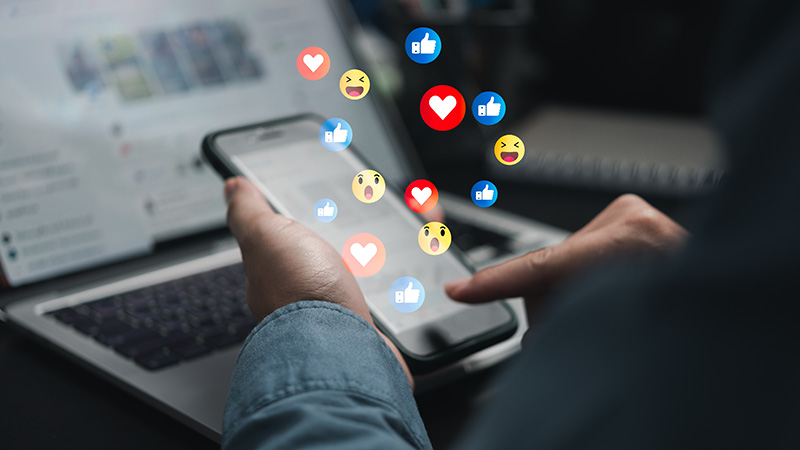Grow your business with the Discover newsletter
Logistics advice & insights straight to your inbox
Subscribe now
As any B2B business knows, sales success depends heavily on relationship building. But as the sector digitalizes, and traditionally face-to-face transactions move online, many have adapted their ways of prospect searching and nurturing. And that’s where LinkedIn is proving to be a valuable solution – a social platform created, after all, especially for networking.
LinkedIn has over 1 billion members spread across 200+ countries and territories1 (handy if you have international ambitions for your business!) Whilst impressive, as every marketer knows, engagement metrics are more significant, and in this area, LinkedIn is also thriving. As of 2023, the platform has seen 27% year-on-year growth in user engagement2. 16.2% of users are active daily, whilst over 48% are active monthly3.

Social selling is a strategic route for salespeople to engage with prospects on social platforms. As the “social” part implies, it has a strong focus on nurturing leads through meaningful interactions. With so many people active on social media, it’s only natural that many businesses make social selling a central part of their sales and marketing strategy.
Selling on social media facilitates a more personal and authentic connection than other sales methods like cold calling. Salespeople can like, comment and share content with prospects to raise awareness of their brand and build credibility. They can interact directly with prospects to gain detailed insights into their needs and challenges, and then personalize their brand content accordingly. And they can use social platforms’ advanced search features to zone in on high-quality leads.
The stats speak for themselves: data from LinkedIn revealed salespeople using social selling tactics had 45% more sales opportunities, were 51% more likely to hit their sales quotas, and outsold 78% of their peers4.

According to LinkedIn, there are a whopping 65+ million business decision makers on the platform5, making it an important marketing channel for B2B businesses. Its fundamental purpose as a networking platform means salespeople can meet prospects in a space where they are actively seeking and engaging with B2B-related content, and conduct natural conversations (rather than pitch-led ones.) Furthermore, LinkedIn’s dedicated targeting tools (of which we’ll expand on later), means it is extremely effective at helping businesses reach the right audience. In fact, 40% of B2B marketers surveyed indicated LinkedIn as the most effective channel for driving high-quality leads6.
Over 90% of B2B marketers use LinkedIn for organic social marketing, and report up to 2x higher conversion rates than other platforms7. With the right strategy, your business too can leverage LinkedIn’s vast audience and targeting capabilities to boost its brand awareness, engagement, lead generation and conversions. Below we explore the best practices to follow to achieve just that.

LinkedIn’s Social Selling Index (SSI) is a tool that measures businesses’ social selling performance on the platform. It considers four factors: establishing a personal brand, finding the right people, engaging with insights, and building relationships. By knowing your SSI score, you’ll identify weaknesses in your social selling strategy which you can then improve on. Our dedicated SSI guide has some tips to help you leverage the tool to your benefit.
First impressions count! Did you know LinkedIn company pages with profile pictures receive six times the number of visitors as those without?8 Meanwhile, the “About Us” section is your opportunity to tell your brand’s story and lay out the value of its product or service. LinkedIn recommends a 2000-character limit to keep readers engaged, so be clear and concise about your strengths and unique selling points. Use keywords and include a link back to your company website where prospects can explore more.
LinkedIn’s Lead Generation Forms can be a good solution for B2B marketers looking for quality leads. Part of the platform’s Campaign Manager suite, the forms make it easy for advertisers to collect quality leads. When a member clicks on your ad’s call-to-action, a native digital form will open, automatically pre-filled with their contact and profile information. So, in just a few clicks, prospects can open your ad (or event invite/discount offer/newsletter signup) and submit their information. This makes the user journey much better – particularly for mobile users who really don’t want to fill in lots of fiddly form fields. Furthermore, you can customize and build the form how you like – for example, adding a final “thank you” page with a link to your website.
Whilst LinkedIn’s Lead Generation Forms have their value, it’s important to create an organic community on the platform first. B2B transactions are, after all, often built on long-established and carefully nurtured relationships, and prospects aren’t going to engage with your ads without believing in your business first.
LinkedIn attracts users looking to engage with topics that really matter to their industry – something your business can leverage to become a trusted part of the story. By posting high-quality content, you’ll demonstrate your expertise on a subject and build your brand’s credibility.
Join relevant professional groups and look at the conversations your target customers are having there – what content can you post to add value? Think too about the questions your current clients often ask, and share insights that answer their pain points.
Post regularly, but remember that online audiences’ attention spans tend to be limited, so be concise and clear with your messaging. Like and comment on others’ content, and don’t be afraid to have an opinion about something – it might just gain the attention of your next customer.
Think about creating a content calendar, too. It will improve the consistency of your posting, and the quality – by allocating adequate time for researching, writing and editing. You can also plan ahead for noteworthy events within your industry – like awareness days or current affairs.
On LinkedIn, your employees are part of your brand. Encourage them to like, comment on, and reshare your business’s content to boost engagement and amplify the messages. They should also be proactively using the network to source and engage with leads themselves.
If you’re running a campaign on LinkedIn, there’s a great service to consider that has been designed to boost B2B advertisers’ conversions. AI-powered Predictive Audiences will combine engagements observed on the LinkedIn platform with your data source to create an audience of people with similar characteristics. This creates a custom audience for your campaign, of individuals who are more likely to convert. With the B2B buying journey becoming increasingly complex, Predictive Audiences can be a smart way for marketers to identify and target the most promising prospects.
For B2B marketers, LinkedIn Groups are a great way to bring together prospects in a space that encourages interactions. You can create a group dedicated to your area of expertise, and share knowledge and insights that will engage and inspire members. The idea is to build a community of like-minded individuals – rather than promoting your brand or company – so bear that in mind when creating content. However, done right, some of these group members may turn into customers, driven by the trust in your brand the group has fostered.
This B2B-focused product promises to be “the best version of LinkedIn for sales professionals,”9 enabling them to better target, understand, engage and maintain relationships with buyers at scale.
Key features of the paid-for tool include:
If you have a Google account, you can opt to receive an email notification when a certain keyword or phrase appears on the web. This way you can stay informed of important industry news to shape your LinkedIn content, so that your brand appears relevant and in touch with trends.
You can also use Google Alerts to monitor your brand mentions online so that you never miss an opportunity to engage with a lead.
Many people miss a trick when sending a connection request on LinkedIn as they don’t realize there’s an option to add a personalized message with it. Don’t make this mistake! To include a message, go to the person’s full profile page on LinkedIn and click the “connect” button located in the introduction card. Then click “add a note” and write a message introducing yourself and explaining why you’re reaching out. Don’t go in too heavy with the sales chat right away – instead open up a friendly conversation that piques their interest in your service enough to accept your request.

As more and more B2B transactions move online, sellers are having to adapt their traditional methods of business. A McKinsey report10 of the sector’s transformation concluded “hybrid sales reps will soon become the most common sales reps,” – i.e. those who combine human relationships with digital sophistication. For that reason, it’s perhaps unsurprising that LinkedIn – with its focus on fostering personal connections – has become the platform of choice for sales reps. As we move into 2024, B2B businesses which invest in their social selling skills will have a competitive advantage.
With a DHL Express Business Account, you’ll receive support from the experts on all aspects of B2B shipping.